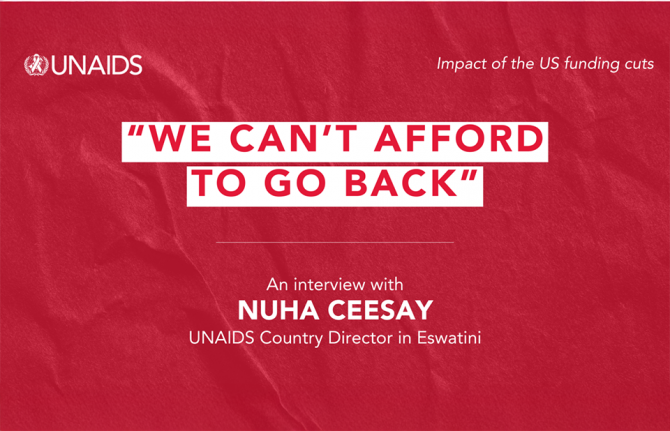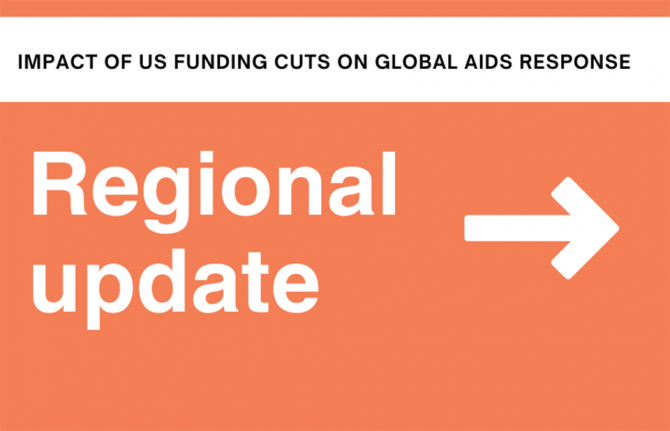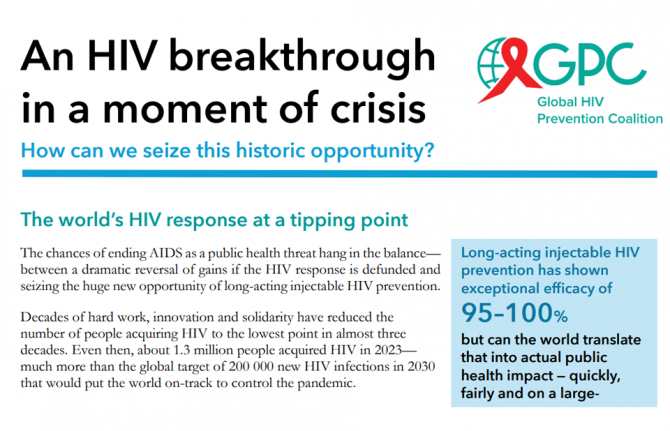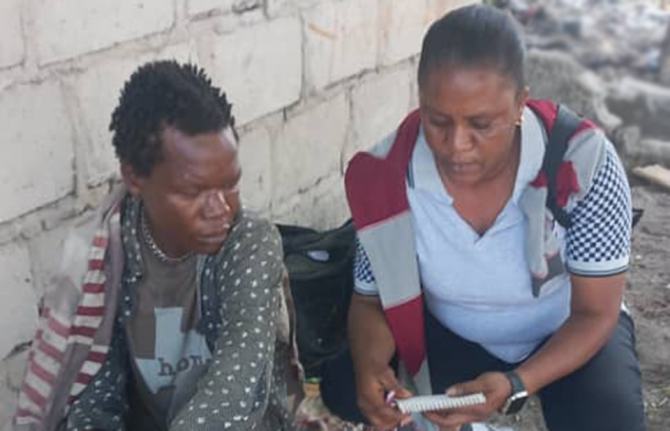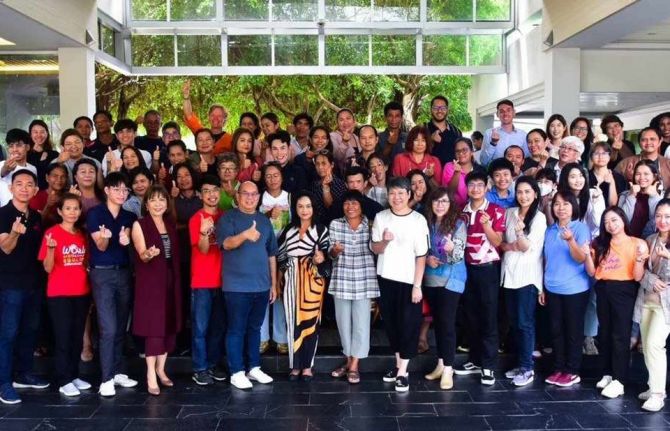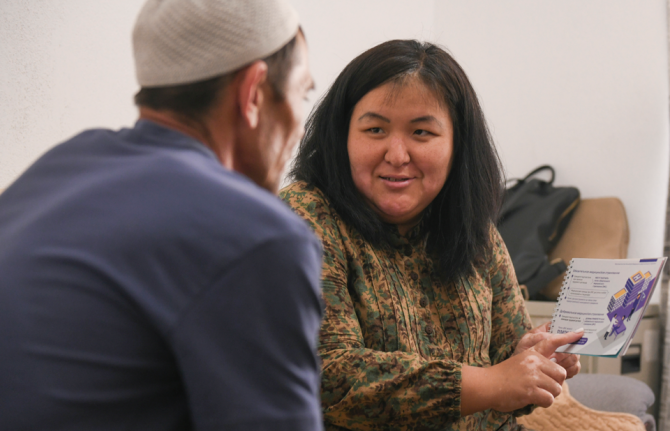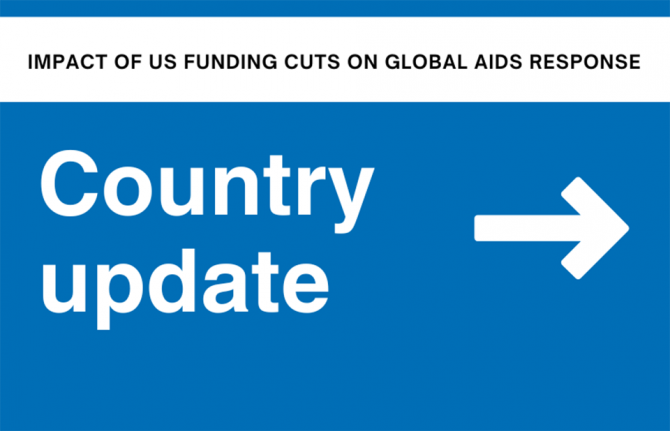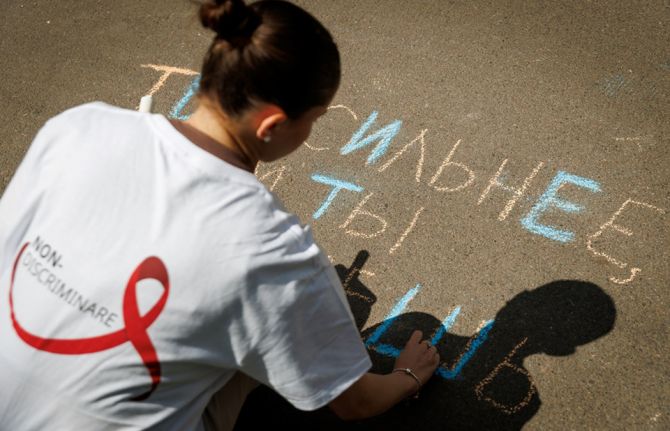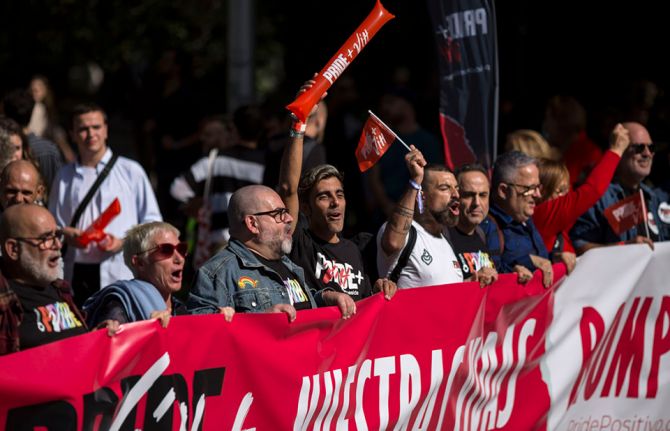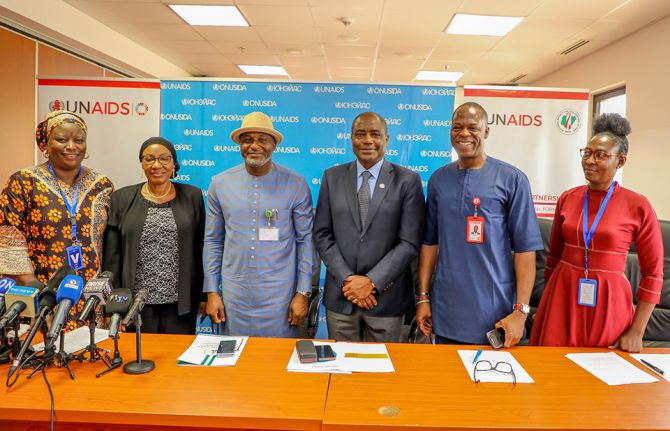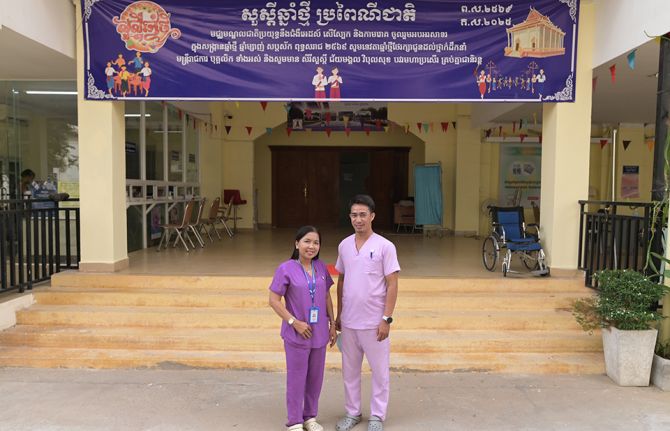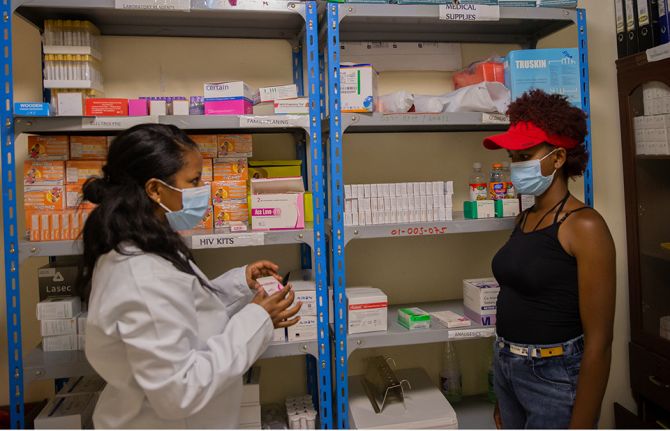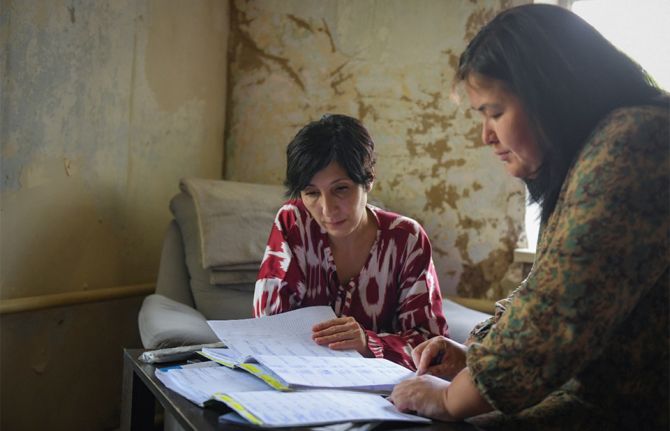
Feature Story
Revival of old traditions brings hope to orphans in Swaziland
30 August 2006
30 August 2006 30 August 2006In times gone by, the ‘KaGogo’ (literally ‘grandmother’s house’) was an integral part of every Swazi homestead – a place of refuge or a neutral site for discussing family matters and resolving disputes. Now the spirit of ‘KaGogo’ is being revived as a way of mobilizing communities in the response to HIV.
Heralded as an example of ‘best practice’ by UNAIDS, KaGogo social centres are being constructed across the country to serve as a meeting place for orphaned children where HIV prevention, care and support activities can take place. Often centres are doubling up as ‘Neighbourhood Care Points’, where education and food are provided.
“Using KaGogo social centres as part of the AIDS response in Swaziland is a new initiative based on traditional ways which people understand and respect,” said UNAIDS Country Coordinator in Swaziland, Mulunesh Tennagashaw. “They empower local communities to look after their orphaned children within their own traditional structure.”
The KaGogo centres respond to the need to support the overwhelming numbers of orphans in Swaziland. There are currently an estimated 63,000 children orphaned by AIDS and extended families are finding it increasingly difficult to cope.
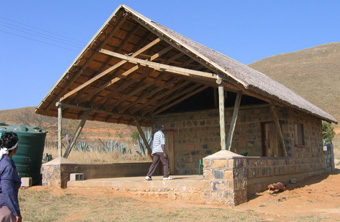
One of the new 'KaGogo' social centres in Swaziland, traditional meeting places now being used to provide essential services for orphaned children. Credit: UNAIDS/R. Evans
Construction of the centres began in 2003 and the KaGogo programme has made huge progress in a very short time. So far 50% of the centres have been completed nation-wide, and a further 30% have been constructed up to roof level. All the KaGogo social centres in Swaziland have been built by the communities themselves who provided labour and local materials.
Mambane’s KaGogo Centre
The KaGogo centre in the Mambane Community, Lubombo region—one of the most remote, poorest and driest parts of Swaziland—is built solidly out of local stone and has a large, airy veranda where meetings are held. It also doubles up as the Neighbourhood Care Point where food and education are provided—the only one in the community.
Under the thatched veranda about 40 children sit on plastic chairs doing sums in shared, well-thumbed maths sheets. The children range in age from seven to 17 years of age. For these and over 40 others registered with the centre, these represent their only school lessons. In addition to educational support, the children are provided with two meals of maize porridge and bean soup a day.
Lungile Matse is one of the volunteer teachers and a caregiver at the KaGogo centre. Recently widowed, and with five children of her own to care for, she still finds time to come to the centre every morning, five days a week.
Lungile and the other volunteers teach maths, siSwati and English using work sheets and books provided by UNICEF. The education they provide here is designed for children of primary school age who haven’t had the chance to go to school, but several of the children attending are older.
A chart on the wall shows that 18 of the children have no parents or are ’double orphans’. Twenty-three have only one parent and 42 are classified as ’vulnerable’. Carers say that many more children would like to come to the centre but live too far away or are too young.
The Mambane community has been badly hit by recurrent drought in recent years, leading to a growing food crisis. The KaGogo social centres have become a central point for distribution of emergency food. UNAIDS Cosponsor organization, the World Food Programme has been providing food at the Mambane centre since July 2005.
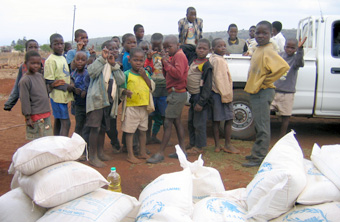
World Food Programme has been providing food to the KaGogo in Mambane since July 2005
“Other hungry children come here looking for food,” said Busisiwe Mazibuko, another of the caregivers. “But we only have enough to give the children here. It’s very hard to turn the other children away but we can’t feed more. We have been trying to grow vegetables for the Care Point, but water is scarce and we don’t have enough seeds.”
In Mambane and across Swaziland, it is envisaged that the community KaGogo social centres will eventually be able to provide other essential services for orphaned and vulnerable children, whilst enabling them to continue living in the community they belong to. Whilst the centres can be used for pre-schooling and non-formal schooling, both for children and adults, the Government is keen that KaGogo centres should be used prepare children for school and channel them into mainstream education.
“I believe the orphans of my areas should be looked after by the people of that community, and not somebody else. We can sustain these kids of ours in the community, using community resources and land. I strongly believe that as a community, we can solve most of the problems, provided we are given financial support,” said Chief Sipho Shongwe, Minister of Health and Social Welfare.
The National Emergency Response Council for HIV and AIDS in Swaziland (NERCHA) and the Global Fund to Fight AIDS TB and malaria provided financial and technical contributions to the KaGogo Social Centre initiative. The estimated cost of each centre is US$ 10 000.
Related links
Helping Ourselves: Community Responses to AIDS in Swaziland
More on Swaziland
World Food Programme
The Global Fund to fight AIDS, Tuberculosis and Malaria

Feature Story
‘Butterfly Brigade’ takes flight to promote HIV prevention in the Philippines
28 August 2006
28 August 2006 28 August 2006In an unusual partnership with provincial authorities, a group of gay activists calling themselves the ‘Butterfly Brigade’ are leading an innovative community awareness campaign on sexual health and HIV prevention in the Philippines. Their work combines wide-reaching public education with social marketing of condoms and care for people living with HIV.
 Health education class is mandatory for massage parlour workers in Kalibo.
Health education class is mandatory for massage parlour workers in Kalibo.The Brigade was founded five years ago by a small group seeking to share knowledge within their own community. Since this time their efforts have blossomed into a network of 164 volunteers, mostly gay men, who run classes in 17 municipalities throughout Aklan province—in high schools and colleges, and within health programmes for women and men involved in sex work.
The Aklan province contains many booming resort areas where the campaign is making a critical difference. By day, the idyllic beaches are full of sunbathers, children frolicking in the water and tourists taking scuba diving lessons. By night, much of the province is a party zone, as local and foreign travellers sway to the music of reggae bands or drink beer in waterfront bars.
“Almost anyone could be at risk of acquiring HIV or another sexually transmitted infection,” said Municipal Health Officer Dr Adrian Salaver. “We can educate people about HIV prevention to try to help reduce those risks.”
HIV prevalence in the Philippines is estimated to be less than 0.1 per cent, one of the lowest rates in the region. But few people have been tested, and experts suspect the real numbers of people living with HIV to be higher. Widespread sex work, inconsistent condom use, early sexual initiation and multiple partnerships could trigger a more serious epidemic, as has occurred in other countries.
Aklan health officials recognize that the Butterfly Brigade’s frank approach to sexuality and strong prevention messages are part of an effective response to this threat. They started working with the initial core group in 2001 with support from the United Nations.
Members were trained to teach other gay men about the ways HIV is spread and how to protect themselves. As the trainers’ expertise increased, they developed their own curriculum and innovative techniques. They became known in their towns as health advocates and were asked to work with wider audiences.
One group that has benefited are the women who work in Aklan’s massage parlours and similar entertainment venues. Following awareness raising drives, employees are now required to have a health certificate indicating they have been tested for sexually transmitted infections (STIs) and have attended a class on disease prevention and condom use.
 Photo: Albert Ilarina teaches sex workers to use condoms and avoid infection.
Photo: Albert Ilarina teaches sex workers to use condoms and avoid infection.Albert Ilarina, chairperson of the Butterfly Brigade, teaches these classes at the Social Hygiene Clinic run by the Women’s Health and Safe Motherhood Project in Kalibo’s hospital.
Twenty-year old Grace has participated in some of Albert’s classes. Grace works in a massage parlour to support her small son and daughter. She earns 200 pesos (about $4) a day, but can make more if she leaves with a client and negotiates a price for other “services”. She explains how the Butterfly Brigade classes have underlined how important it is to try to negotiate condom use with clients. “Sometimes I use condoms, but about three of every five customers don’t want to use them,” she says. “I have had gonorrhoea but I never knew about HIV before. Now I am scared. I want to buy condoms and start using them every time.”
Benefits from the Butterfly Brigade’s initiative are evident throughout the province. The Aklan health system now offers a “full package” of HIV-related services, including condom promotion, voluntary testing and counselling, and care. Last year the United Nations provided antiretroviral drugs for 14 people living with HIV; the Global Fund to Fight AIDS, Tuberculosis and Malaria now supports their treatment.
“The Butterfly Brigade is fun to be a part of and we do help,” says Butterfly co-founder Nono Bantigue, a municipal counsellor in Balete and chair of the town’s Committee on Women’s and Children’s Welfare.
The programme also provides HIV awareness training to police officers and merchants, as well as to boatmen and tricycle drivers. Brigade members have also persuaded Boracay officials to let them install a condom vending machine in an area known as a pickup spot.
“Local governments, the provincial health office and the local business sector have all recognized our work,” reports Bantigue. With support from the United Nations, municipal mayors and provincial health officials from all over the country have visited Aklan with a view to replicate its peer education network.
“The Butterfly Brigade are helping raise awareness and break down stigma – which is key to getting ahead of the epidemic in the Philippines,” said UNAIDS Country Coordinator for the Philippines, Dr. Marlyn Filio-Borromeo.
Related

Feature Story
India launches ‘grassroots’ outreach for HIV
08 August 2006
08 August 2006 08 August 2006India’s villages and towns join hands in the AIDS battle
New Delhi, August 8: The government of India has launched its largest ever outreach on AIDS to the country’s elected representatives with the hosting of first national convention of District Council Chairpersons (Zilla Parishad Adhyakshas) and Mayors.
The convention, which was held at the National conference centre in New Delhi at the beginning of August, brought together more than 500 representatives from the local town and village governance mechanisms- ‘Panchayati Raj’ and ‘nagarpalika’ institutions - to join the AIDS response at the district level.
A joint initiative of the Government of India, the National Aids Control Organization (NACO), the Parliamentarians’ Forum on HIV/AIDS and the Joint United Nations Programme on HIV/AIDS (UNAIDS), the convention is part of an effort to build a country wide community of locally elected leaders in the rural and urban areas who have the potential to influence policies, programming and resource management., making mainstreaming a reality in the Indian context.
With an estimated 5.21 million people aged between 15 and 49* living with HIV in India, the country has launched a major response in the fight against HIV. Working in this way at the district level, the ‘Zilla Parishad initiative’ is a step towards strengthening local responses at the grassroots level – through communities and households - and increase communities ability to face and respond to HIV and AIDS.
“India’s District Chairpersons and Mayors wield a large amount of influence that can be positively directed in creating awareness and removing stigma in the drive against HIV. They can ensure HIV related issues are addressed through proper planning and budgetary allocation and as community leaders they can address stigma and discrimination by dispelling myths about the epidemic,” said Dr. Denis Broun, Country Coordinator, UNAIDS, who spoke at the convention.
The convention delegates were also addressed by Shri Oscar Fernandes, Union Minister and Convener, Parliamentarians’ Forum on HIV/AIDS; Shri Mani Shankar Aiyer, Union Minister for Panchayati Raj; Dr. Anbumani Ramadoss, Union Minister for Health and Family Welfare, Shri Jaipal Reddy, Union Minister for Urban Development and Ms. K. Sujatha Rao, Director General , NACO.
As part of the convention, discussions took place on the rural and urban contexts of AIDS in India. HIV related targets and programmes were shared with the objective of achieving seamless implementation across the nation. In seeking support of the decentralized authorities, this Convention becomes the basis of decentralized planning envisaged in ‘Phase III’ of the National AIDS Control Programme, which is expected to be launched in November 2006.
“The challenges that the HIV epidemic poses need to be addressed at the district and community levels. By involving the Zilla Parishad chairpersons we are working towards tackling the epidemic at the level where it touches individual lives,” said Ms. Sujatha Rao, Director General, NACO.
Given the influence and access of District Council Chairpersons and Mayors at town and village levels they can make significant differences in the AIDS response by influencing district development plans to ensure HIV related activities are included and appropriate budgets allocated and allocating their own funds to the response. They can also advocate with heads of various departments (especially health and education) to introduce systems that can help reduce stigma and discrimination and provide relevant information and referrals to communities who access their services. As community leaders they can talk about HIV in all fora to further address stigma and discrimination and as political representatives they can advocate to bring HIV to the top of the political agenda.
Highlighting the critical role of local-level institutions in the HIV and AIDS battle, Shri Oscar Fernandes, Convenor of the Parliamentarians’ Forum on HIV/AIDS said, “Zilla Parishad Chairpersons have many strategic advantages which will enable them to influence the HIV programmes at the district level. The aim of this Convention is to sensitize district level representatives and thus make a difference to the HIV situation in the country at the grassroots level.”
The Convention concluded with the signing of a Declaration of Commitment by the District Chairpersons and Mayors. The declaration outlines the way forward and pledges sincere engagement in the HIV response at the district and community levels.
*NACO figures, 2005
Related links
UNAIDS India
National AIDS Control Organization (NACO)
Photographs from the event:

(left to right): Kumari Shelja, Minister of Urban Employment & Poverty Alleviation, Mr. Oscar Fernandes, Union Minister and Convenor Parliamentarians’ Forum on HIV/AIDS; Mr. Anbumani Ramdoss, Union Minister of Health and Family Welfare; Mr. Manishankar Aiyar, Union Minister for Panchayati Raj; Shri Jaipal Reddy, Union Minister for Urban Development at the Convention
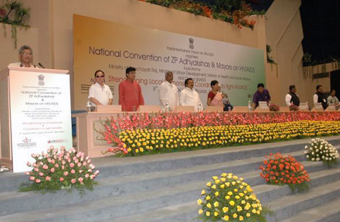
Shri Sitaram Yechuri, Honourable Member of Parliament addresses the Convention
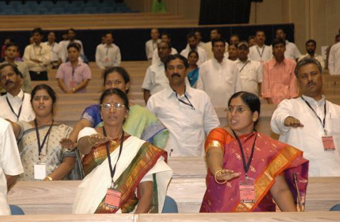
ZP Adhyakshas and mayors pledging support to the AIDS response.

ZP Adhyakshas and Mayors signing the Oath of Commitment.
Related

Feature Story
UNAIDS Executive Director meets with Prime Minister of India
03 August 2006
03 August 2006 03 August 2006
Dr Peter Piot met with Indian Prime Minister Dr Manmohan Singh. The Prime Minister's leadership has put the AIDS response on the national political agenda. As the Chairperson of the National Council on AIDS, Dr. Singh has developed a multi-ministerial task force comprising of 31 ministries and seven state governments for a coordinated multi-sectoral response to the HIV epidemic in India.
Related

Feature Story
Putting HIV on the front page
31 July 2006
31 July 2006 31 July 2006Sri-Lankan journalists reflect on media role in reducing stigma and discrimination
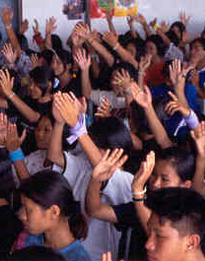
The media has a key role to play in raising awareness on HIV and reducing AIDS-related stigma and discrimination, even in countries with low HIV prevalence rates.
This summer, a group of Sri Lankan journalists joined a special UNAIDS workshop in Bangkok to better examine the powerful role the media can play within the AIDS response. Despite relatively low levels of HIV infection within Sri Lanka, the country is nevertheless at real risk of a potential epidemic. Increasing rates of sexually transmitted infections, high levels of internal and external migration, apparent increases in the numbers of sex workers and low use of condoms, all combine to put people at greater risk of HIV. The media in Sri Lanka therefore plays a key role in ensuring that HIV stays on the political agenda. It is also a major vehicle for prevention messages to inform people how to protect themselves and reduce the stigma and discrimination associated with AIDS.
The three day intensive Media Exposure Tour, organized by UNAIDS Regional Support Team for Asia Pacific, brought together 12 journalists from Sri Lankan print, radio and television media and four Government representatives from the Ministry of Health and the Ministry of Education to examine the situation in their country and how they could best put their media skills to work to help get ahead of the epidemic and combat discrimination.
Prior to the workshop, only two of the 16 participants had ever met a person living with HIV and most of them said they had limited experience in HIV and AIDS issues.
“We wanted to provoke the participants to reflect on their own behaviours and attitudes and on what each of them can do to make a difference,” said Mechai Viravaidya, founder of the Thai Population and Community Development Association and a resource person in this initiative. In his welcoming address he urged all participants to “think outside the box and challenge societal norms to break down barriers.”
The tour started with an assessment of what media can do to make a difference in the AIDS response, which included: building awareness on HIV in all groups, socializing, reducing stigma and discrimination, improving education in schools and engaging politicians.
Over the three days participants reviewed the journalistic ethical guidelines coined as RESPECT (Responsible, Ethical, Sensitive, Participative, Empowering, Compassion and Trust) and also had a chance to learn from and discuss with a number of regional journalists and artists who presented their own experience and work on HIV and AIDS.
The programme provided the journalists with a variety of rich experiences engaging with a range of people from organizations representing different aspects of the response to HIV in Thailand and the region. They met with Frika, a young Indonesian activist living with HIV and visited a number of centers in Bangkok such as the Injecting Drug Users treatment centre and the Mercy center. They also learned about the empowerment of sex workers at the Empower office located in an area of Bangkok known for commercial sex work.
“I am not the same journalist who came from Sri Lanka,” said TV producer Nirosha Damayanthi to describe the impact of the Tour on her. “Hearing how Frika turned a new leaf in her life created in me the urge to make a difference in the field of HIV and AIDS.”
Less than two weeks after the end of the Tour, articles on HIV and AIDS began to appear in Sri Lanka media telling Frika’s story about overcoming stigma and discrimination from her own family to become the voice of People living with HIV in Asia and disseminating hard facts about the spread of the disease and the importance of respect and empathy towards the most vulnerable people in society.
Tour participant Ramani Prematillake Bogoda wrote: “people living with HIV should not be cornered or abandoned. They too are entitled to the rights and benefits of society.”
Another journalist from the tour, Buddhi Jayawardene from the Health Education Bureau, has started a weekly live radio discussion on HIV to build on the momentum.
“Speaking about the disease is the first step towards reducing the stigma around people living with HIV and preventing new infections,” said David Bridger from the UNAIDS Regional Office in Bangkok.
“The media plays a critical role in breaking the silence,” he added.
The Bangkok Media Exposure Tour is an activity of the National HIV/AIDS Prevention Project in Sri Lanka, supported by the World Bank. The UNAIDS Regional Support Team for Asia and the Pacific provided support in developing the program and hosting the Media Exposure Tour.
The 8th International Congress on AIDS in Asia and the Pacific will be held in Colombo, Sri Lanka 19-23 August 2007.
Related

Feature Story
Access to treatment: Secretary General and pharmaceutical companies meet
24 July 2006
24 July 2006 24 July 2006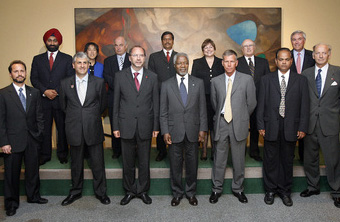
UN Photo/Mark Garten
The UN Secretary General, CEOs from the world’s leading pharmaceutical companies and UN officials met in New York to explore ways in which the companies and United Nations can work collaboratively in expanding access to HIV treatment and care in developing countries.
The meeting represents the first of its kind between both research and development - or ‘brand name’ – pharmaceutical companies, generic development companies and United Nations bodies.
Following the discussion, the Secretary General issued a statement in which he outlined a number of commitments to assist international efforts to ensure universal access to HIV treatment, prevention, care and support, as called for at the High Level Meeting on AIDS held in June 2006.
Read the Secretary-General’s Statement
Among other commitments, the companies committed to continue to review individually their offers of products and the prices of their existing and new HIV medications and diagnostics to make them more affordable and accessible in low-and-middle income countries; and to give greater priority to research and development of new and improved antiretroviral treatments for children – currently extremely lacking in the AIDS response.
The United Nations in turn committed ensuring the continuing revision and updating of key treatment guidelines, to help the companies turn their commitments into action and to continue the work with Governments, donors and the pharmaceutical companies in developing forecasting models to predict demand and supply of HIV medications and diagnostics in developing countries.
In 2001, seven major ‘brand’ pharmaceutical companies first met with the Secretary General to discuss improving affordability and accessibility of HIV medications. Since this time there been significant advances in the global response to AIDS, including in the provision of care support and treatment services in developing countries. Earlier this year WHO and UNAIDS reported that 1.3 million people living with HIV are receiving antiretroviral therapy by the end of 2005.
Related Links:
New York, 24 July 2006
Statement by the Secretary-General on his meeting with Pharmaceutical Executives on HIV/AIDS
Related

Feature Story
Investigating the impact of AIDS in Asia/Pacific – independent commission on AIDS launched
17 July 2006
17 July 2006 17 July 2006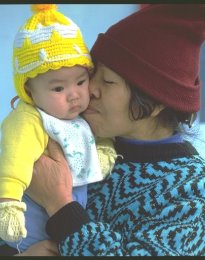
New Delhi, 15 July 2006 – A new body to study the spread and impact of HIV and AIDS in the Asia Pacific region was launched on Saturday (15 July) in New Delhi.
The independent Commission on AIDS in Asia and the Pacific, chaired by the Chief Economic Advisor to the Prime Minister of India, Dr Chakravarthy Rangarajan, consists of 10 leading economists, scientists, civil society representatives and policy-makers from across the region. Over a period of 18 months, the Commission will conduct an objective analysis of the impact and developmental consequences of the AIDS epidemic in the region, and what this might mean to the socio-economic environment in the medium and long term. The Commission’s findings will be summarized in a report with recommendations for a set of measures designed to mobilize leaders to adequately respond to the epidemic in the region.
At the end of 2005, there were an estimated 8.3 million persons living with HIV in Asia and the Pacific and the numbers are growing rapidly. Over half a million people died of AIDS last year alone “Faced with these startling figures and such a grim scenario, development experts need to describe in greater detail the kind of impact AIDS will have on societies and the development of countries in the region. To date, this sort of analysis has been inadequate for Asia and the Pacific and data is still limited” said Dr Rangarajan during the launch. “The goal of this Commission and its eminent thinkers is to generate adequate information to show to leaders and governments in the region the urgent necessity to invest in AIDS if they are to maintain their achievements in development,” added Dr Rangarajan.
The Joint United Nations Programme of AIDS (UNAIDS) will provide the commission with logistical support in its initial months and has contributed the funding towards the work of the Commission on AIDS in Asia and the Pacific. Mr JVR Prasada Rao, Director, UNAIDS Regional Support Team for Asia and the pacific in Bangkok, sits as the Secretary to the Commission.
“Such an important analysis of the impact of HIV and AIDS should be conducted through a group of experts who can make an objective assessment of the situation in the region, and bring out a report which can carry credibility with national governments and civil society alike,” Mr Rao said.
“We are confident this Commission will make a real difference and move the agenda forward for the Aisa Pacific region response to HIV and AIDS.”
The commission's expected work includes studying the impact of AIDS on human resources, labour productivity, poverty reduction, social stability and household savings.
It will also examine the spread of the virus in coming years, and how it could be reduced by raising national and international efforts.
A series of sub-regional consultations in different venues in South Asia, South-East Asia and the Pacific will be held, with inputs coming from local academics, government officials, civil society, multilateral organizations and experts in the field.
The Commission is expected to release a final Report at the end of 2007.
Related

Feature Story
RAISING AIDS AWARENESS AMONG POLICY MAKERS IN INDIA
07 July 2006
07 July 2006 07 July 2006First legislative forum on HIV and AIDS in Bihar state

The Indian North Indian state of Bihar is the first in India to have established a forum with a formal constitution and institutional mechanisms for elected representatives to address AIDS issues in the state.
The Bihar Legislative Forum on HIV and AIDS (BLFA) was launched last week at a symposium in Bihar’s capital, by Shri Nitish Kumar, Bihar’s Chief Minister, as a way to raise AIDS awareness among policy makers in the state and to build capacity to address the challenges posed by AIDS.
Alerted by the growing number of infections, a number of Indian officials, including a former minister, submitted a proposal to create a forum for policy makers where they could learn more about HIV and AIDS and engage in dialogues on possible responses in the state.
In his opening address the Chief Minister welcomed the initiative and recognized the critical importance of leadership in the response to AIDS.
Reported numbers of HIV infections in the state (Bihar State AIDS control Society)
| 2001 | 2003 |
| 192 | 2500 |
This initiative has come at the right time,” said Symposium organizer, elected member and speaker of Bihar legislative assembly, Mr Uday Narayan Chaudhary. “We are aware of the devastating effects of AIDS, but we need to know more about how it spreads and what we can do about it.”
“Half of the recently elected village representatives are women. This amounts to almost 100 000 women who could play a critical role in increasing people’s awareness about HIV at the grassroots level,” he added.
Chaudhary also said that heightened awareness is a key element to reducing the social stigma associated with HIV and AIDS.
Recognizing the need for consolidated action in Bihar, the Chief Minister Shri Nitish Kumar called for strengthening the public awareness campaign and committed to expand health infrastructures at various levels in the state. He also committed to support seminars and workshops to educate more than 200 000 elected village representatives on issues of public importance such as agriculture, rural development as well as AIDS.
Supporting these initiatives, Denis Broun, UNAIDS country coordinator in India, underlined the importance of political leadership to move the response to AIDS one step further. “Facing up to the issue of AIDS and taking concrete action such as this is vital to getting ahead of the epidemic,” he said. “By creating this forum, , Bihar’s leaders have introduced a critical link that will be key to Bihar’s victory in its AIDS response.”
Related

Feature Story
Eastern Europe and Central Asia are facing the challenge
16 May 2006
16 May 2006 16 May 2006
Under the theme “facing the challenge”, the first Eastern European and Central Asian AIDS conference (EECCAAC) welcomed around 1500 participants in Moscow from 15 to 17 May. This first regional conference provided an important forum for political leaders, scientists and researchers, people living with HIV and representatives from civil society to take stock of the AIDS response in the region. The EECAAC will be held every two years, and will replace the annual Russian National AIDS Conference in Suzdal.
During the last decade, the countries of Eastern Europe and Central Asia have experienced one of the world’s fastest growing HIV epidemics. By the end of 2005, more than 1.6 million people were already living with HIV in the region and around 75% of the reported HIV infections between 2000 and 2004 were in people under 30. The escalating epidemic threatens to accelerate the demographic crisis, seriously impact the workforce and national security, and put a heavy burden on the already strained health sector in the region.
This conference is being held in light of recent expanding national health spending in the most affected countries of the region. Domestic spending on AIDS in Russia is slated to increase by 20 times in 2006 to over US$100 million. In 2005, Russian Federation President Vladimir Putin established HIV prevention as a national priority.
“AIDS is one of the greatest challenges facing Eastern Europe and Central Asia today,” said Dr. Peter Piot, Executive Director of UNAIDS, during his keynote address at the conference. “Fear and stigma are truly the best friends of HIV. To get ahead of the epidemic, stigma and discrimination must be tackled head-on, and HIV prevention and treatment services must be urgently scaled up.”
The conference programme is divided into three parts: Leadership, Science and Community. The Leadership programme will focus on political, social, business and media leadership necessary to stem the epidemic. The scientific programme will bring together clinicians and researchers to provide critical insight into the various aspects of addressing HIV in the region (ranging from epidemiological surveillance to clinical treatment). The community programme will highlight the response of AIDS service organizations, NGOs and people living with HIV and provide a forum for exchange of knowledge and experience.
The expected outcomes of the conference are enhanced political leadership and commitment, increased technical capacity building, and partnerships with civil society and people living with HIV. The conference will set the stage for three major events on the global AIDS response: the High Level Meeting on AIDS in New York, June 2006; the G8 Summit in Saint Petersburg, July 2006; and the 16th International AIDS Conference in Toronto, August 2006.
The Conference Organizing Committee is co-chaired by Dr. G.G. Onishenko, Head of the Federal Service for Supervision of Consumers Protection and Welfare, Dr. Peter Piot, Executive Director of UNAIDS, and Craig McClure, President of the International AIDS Society. The committee is composed of international organizations and representatives of Russia and other CIS countries.
Related Links
Photo Gallery
Speech by UNAIDS Executive Director Dr Peter Piot
Speech by Prof Lars O. Kallings, Special Envoy of the Secretary General for HIV/AIDS in Eastern Europe and Central Asia (ru)
Related

Feature Story
Sharing skills, support and hope
11 May 2006
11 May 2006 11 May 2006How one woman’s crusade is making a difference in Kenya
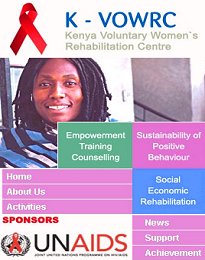
When rural girls and young women move to Kenya’s capital city, Nairobi, in search of a better life, not all of them find it. Faced with limited educational training and the difficulties of earning a living—some end up as sex workers and at risk for HIV.
Professor Elizabeth Ngugi, a nurse by training, has been looking out for these young women since 1992 when she founded the Kenya Voluntary Women Rehabilitation Centre (KVOWRC). The center reaches out to sex workers in the slums of Nairobi who are looking for a better life.
The center offers skills training and has a micro finance programme. Graduates of KVOWRC are now running small business. Professor Ngugi says by providing these services she and her team are helping young women re-build their self-esteem and make positive changes in their lives. “Every human being has a right to exploit their potential to the full. The world has the obligation to give vulnerable women and children a chance,” she says.
In the city where number of children aged between 10 and 18 involved in sex work is increasing at an alarming rate, KVOWRC also focuses on HIV education and prevention, peer counseling and home based care for those who need it.
For the younger girls, many of whom are teenage mothers, the centre also provides a home and pays for school fees so they can complete their education. The centre also offers vocational training programs in tailoring, dressmaking, weaving, and tie and dye hairdressing, which are boosting their income and empowering them to abandon risky behavior. Most of the girls who come to the centre choose not to go back to the streets.
For one graduate it took a hairdressing course and a hair dryer to turn her life around. “It was not easy for me to get a job because I had no experience” she says. “Thanks to the KVOWRC training, I opened a small beauty salon, and am now able to pay my rent and buy food and clothing for myself and my two children.”
Related links
KVOWRC website: www.kvowrc.or.ke
Related
 “Who will protect our young people?”
“Who will protect our young people?”

02 June 2025
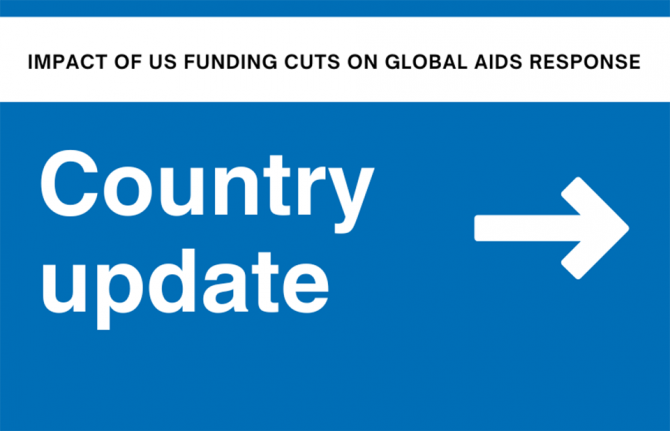 Impact of US funding cuts on HIV programmes in Kenya
Impact of US funding cuts on HIV programmes in Kenya

04 April 2025

